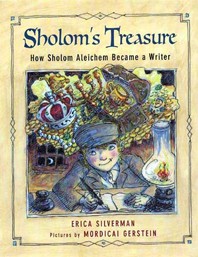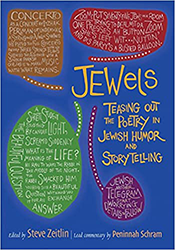By
– November 10, 2011
This year, Sholem Aleichem would be 150 years old. L’Omeer Trinkn a lekheiyim (let’s drink a toast) to celebrate the publication of this new translation of his best known works.
Sholem Aleichem (1859 – 1916), the pen name of the most beloved and best-known Yiddish writer Sholem Rabinovitch, is someone I have loved for years and is ‘ever-present’ in my home. You ask what I mean by that. Back in 1961, while I was living in Paris, Ida Kaminska’s company, the Yiddish State Theatre of Poland, came to Paris with two plays, one of which was Tevye der milkhiker (Tevye the Dairyman) starring members of the renowned theatrical Kaminska family. It was a ten-handkerchief production; five handkerchiefs for crying and five for laughing. About that same time, my husband and I traveled to London, where we purchased three black and white lithographs by the Russian artist Abraham Kaplan of scenes from Sholem Aleichem’s stories. My favorite has always been Tevye sitting on a bench talking to Sholem Aleichem with the legendary town Kasrilevka in the background. This is how Sholem Aleichem came to be a presence in my home and has remained as a good guest.
So with all of these memories and images, I set out to reread these two magnificent novels published in a new translation by Aliza Shevrin. Dan Miron has written a major introduction to these two literary masterpieces. It includes a review of Sholem Aleichem as a writer, an in-depth discussion of his created characters, Tevye and Motl, as well as an exploration of the surrounding religious and political changes occurring in that area of the world at the end of the 19th and beginning of the 20th centuries.
For those who think they already know Tevye because they had seen the Broadway production or the film of Fiddler on the Roof, they are in for a surprise when they read the monologues on which the musical is based. In the novel, there is a depth and richness of characters that did not fully transfer to the musical. And the language! As Dan Miron writes: “No one else was to tap the immense resources of Yiddish as he [Sholem Aleichem] did while endowing his entire corpus…with unparalleled linguistic élan and unflagging rhythmic drive.” This is equally true for the second novel in this volume, Motl the Cantor’s Son.
The translator, Aliza Shevrin, has also interpolated into the text the actual Talmudic quotations (with a source sometimes noted), along with Tevye’s “interpretations,” which are often colorful and creative extensions of the original. For example, in the chapter “Today’s Children,” Tevye says: “You were talking about today’s children. Here’s what Isaiah said: I have nourished and brought up children—you bring them into the world, they make your life miserable, you sacrifice yourself for them, you slave away night and day, and what comes of it?” Thus, by having the quotation as part of the story, the reader gains a multi-layered dialogic reading experience.
Just a word about Motl the Cantor’s Son, which is no doubt less familiar to many: It is an immigration tale of coming to America. The descriptions of seeing New York City for the first time through the eyes of this young nine-year-old Motl are beyond delicious. For example:
As you read, you enter into the characters and their experiences.
Because these novels are written as monologues with a great deal of dialogue in an oral style, they demand to be read out loud. Find a friend and read them chapter-by-chapter aloud to each other. If not, then welcome in Sholem Aleichem, put two glasses of tea on the table and begin the reading. What a marvelous storyteller Sholem Aleichem is; he is also a great listener!
There is a two-page glossary of selected Hebrew, Yiddish, and Russian words at the end of the book.
Sholem Aleichem (1859 – 1916), the pen name of the most beloved and best-known Yiddish writer Sholem Rabinovitch, is someone I have loved for years and is ‘ever-present’ in my home. You ask what I mean by that. Back in 1961, while I was living in Paris, Ida Kaminska’s company, the Yiddish State Theatre of Poland, came to Paris with two plays, one of which was Tevye der milkhiker (Tevye the Dairyman) starring members of the renowned theatrical Kaminska family. It was a ten-handkerchief production; five handkerchiefs for crying and five for laughing. About that same time, my husband and I traveled to London, where we purchased three black and white lithographs by the Russian artist Abraham Kaplan of scenes from Sholem Aleichem’s stories. My favorite has always been Tevye sitting on a bench talking to Sholem Aleichem with the legendary town Kasrilevka in the background. This is how Sholem Aleichem came to be a presence in my home and has remained as a good guest.
So with all of these memories and images, I set out to reread these two magnificent novels published in a new translation by Aliza Shevrin. Dan Miron has written a major introduction to these two literary masterpieces. It includes a review of Sholem Aleichem as a writer, an in-depth discussion of his created characters, Tevye and Motl, as well as an exploration of the surrounding religious and political changes occurring in that area of the world at the end of the 19th and beginning of the 20th centuries.
For those who think they already know Tevye because they had seen the Broadway production or the film of Fiddler on the Roof, they are in for a surprise when they read the monologues on which the musical is based. In the novel, there is a depth and richness of characters that did not fully transfer to the musical. And the language! As Dan Miron writes: “No one else was to tap the immense resources of Yiddish as he [Sholem Aleichem] did while endowing his entire corpus…with unparalleled linguistic élan and unflagging rhythmic drive.” This is equally true for the second novel in this volume, Motl the Cantor’s Son.
The translator, Aliza Shevrin, has also interpolated into the text the actual Talmudic quotations (with a source sometimes noted), along with Tevye’s “interpretations,” which are often colorful and creative extensions of the original. For example, in the chapter “Today’s Children,” Tevye says: “You were talking about today’s children. Here’s what Isaiah said: I have nourished and brought up children—you bring them into the world, they make your life miserable, you sacrifice yourself for them, you slave away night and day, and what comes of it?” Thus, by having the quotation as part of the story, the reader gains a multi-layered dialogic reading experience.
Just a word about Motl the Cantor’s Son, which is no doubt less familiar to many: It is an immigration tale of coming to America. The descriptions of seeing New York City for the first time through the eyes of this young nine-year-old Motl are beyond delicious. For example:
The ride into the city of New York is dreadful. The ride itself isn’t so bad, but transferring from one trolley to another is difficult. As soon as you sit down— aha! You’re flying like eagles through the air over a long, narrow bridge, afraid for your life. They call it the elevated here. Do you think that’s it? Just wait a bit. You get yourself out of the elevated, and you have to switch over to another car. You reach it by going down steps, as if into a cellar, where you ride under the ground so fast that your eyes pop out of your head. They call this the subway. Why is one car called elevated and the other subway?
As you read, you enter into the characters and their experiences.
Because these novels are written as monologues with a great deal of dialogue in an oral style, they demand to be read out loud. Find a friend and read them chapter-by-chapter aloud to each other. If not, then welcome in Sholem Aleichem, put two glasses of tea on the table and begin the reading. What a marvelous storyteller Sholem Aleichem is; he is also a great listener!
There is a two-page glossary of selected Hebrew, Yiddish, and Russian words at the end of the book.
Peninnah Schram, well-known storyteller & author, is Professor of Speech and Drama at Yeshiva University’s Stern College. Her latest book is an illustrated anthology, The Hungry Clothes and Other Jewish Folktales (Sterling Publishing) and a CD, The Minstrel & the Storyteller, with singer/guitarist Gerard Edery (Sefarad Records). She is a recipient of a Covenant Award for Outstanding Jewish Educator and the 2003 National Storytelling Network’s Lifetime Achievement Award.



